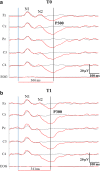Direct antivirals and cognitive impairment in hepatitis C: a clinical-neurophysiologic study
- PMID: 32910431
- PMCID: PMC7716927
- DOI: 10.1007/s13365-020-00904-6
Direct antivirals and cognitive impairment in hepatitis C: a clinical-neurophysiologic study
Abstract
Cognition was assessed in hepatitis C virus (HCV) patients, who did not meet the criteria for a minimal hepatic encephalopathy. Their liver function was compensated. We then disentangled potential cognitive changes associated with a sustained virologic response at 12 weeks (SVR-12), following treatment with direct antiviral agents (DAAs). We studied 23 selected HCV patients with a battery of standard neuropsychological tests, and with recordings of the P300 wave, a cerebral potential of "cognitive" significance. There was a baseline evaluation (T0) and a second one 6 months later (T1). We had 2 control groups of comparable age and sex, i.e., 15 patients suffering from non-alcoholic fatty liver disease (NAFLD) and 15 healthy subjects. At T0, we detected a significant (p < 0.05) cognitive impairment in the HCV group, which involved episodic and working memory, attention, visuospatial and verbal abilities, executive functions, and logic reasoning. The P300 latency was significantly (p < 0.05) delayed in the group. At T1, we observed some significant (p < 0.05) HCV recovery in given test domains, e.g., memory, executive functions, and reasoning. Accordingly, the P300 latency shortened significantly (p < 0.05). HCV patients exhibited subtle cognitive defects, somehow independent of their liver condition, possibly linked to direct or indirect brain involvement by the virus. These defects partly recovered following the SVR-12, as achieved through DAAs. The P300 wave was a valid neurophysiologic counterpart of these changes. DAAs can have a role in the early preservation of cognition in HCVs.
Keywords: Cognitive impairment; Direct antiviral agents; Hepatitis C; Neuropsychology; P300 wave.
Conflict of interest statement
The authors declare that they have no conflicts of interest.
Figures



References
-
- Amodio P, Valenti P, Del Piccolo F, Pellegrini A, Schiff S, Angeli P, Poci C, Mapelli D, Iannizzi P, Gatta A. P300 latency for the diagnosis of minimal hepatic encephalopathy: evidence that spectral EEG analysis and psychometric tests are enough. Dig Liver Dis. 2005;37:861–868. - PubMed
-
- Borkowski JG, Benton AL, Spreen O. Word fluency and brain damage. Neuropsychologia. 1967;5:135–140.
-
- Byrnes V, Miller A, Lowry D, Hill E, Weinstein C, Alsop D, Lenkinski R, Afdhal NH. Effects of anti-viral therapy and HCV clearance on cerebral metabolism and cognition. J Hepatol. 2012;56:549–556. - PubMed
-
- Child CG, Turcotte JG. Surgery and portal hypertension. Major Probl Clin Surg. 1964;1:1–85. - PubMed
Publication types
MeSH terms
Substances
LinkOut - more resources
Full Text Sources
Medical
Miscellaneous

